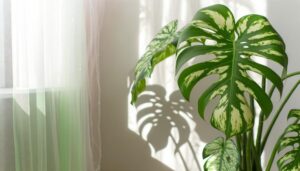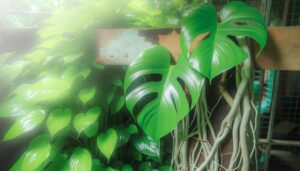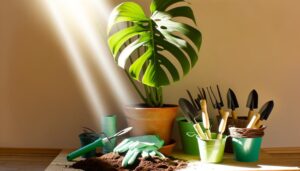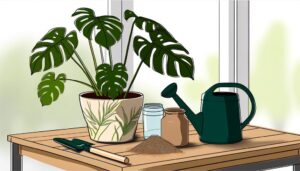Best Soil for Monstera Adansonii: Top Mixes and Tips!
For prime growth of Monstera Adansonii, use a well-aerated soil mix that retains moisture yet drains effectively. Consider a blend containing peat moss for nutrient availability and perlite or orchid bark to enhance root health and aeration.
A pH range between 5.5 to 7.0 is ideal for nutrient uptake and robust plant vigor. Brands like FoxFarm and Espoma offer outstanding options with organic matter and proper aeration components.
Maintaining these conditions can prevent root rot and foster healthy growth. To achieve even better plant health and growth, explore additional details on soil composition and management.
Optimal Soil Mix for Monstera Adansonii
| Component | Description | Proportion | Benefits |
|---|---|---|---|
| Potting Soil | General-purpose potting soil that forms the base of the mix. | 40% | Provides essential nutrients and a stable base for roots. |
| Perlite | Lightweight volcanic rock that improves soil aeration. | 20% | Enhances drainage and prevents root rot. |
| Orchid Bark | Coarse bark pieces typically used for orchid growing. | 20% | Increases soil structure and allows for better root growth. |
| Coconut Coir | Natural fiber from coconut husks that helps retain moisture. | 10% | Retains moisture while improving soil aeration. |
| Charcoal | Activated charcoal pieces that help to keep the soil fresh. | 10% | Absorbs toxins and enhances soil drainage. |
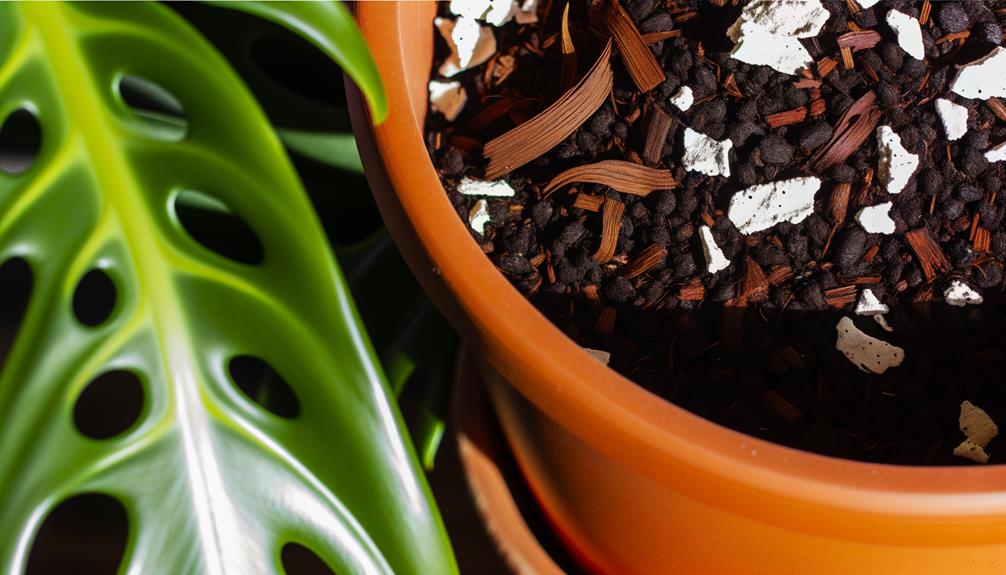
Key Takeaways
- Use well-aerated soil that includes perlite or orchid bark to prevent root rot.
- Ensure the soil retains moisture and includes organic matter like peat moss or compost.
- Maintain soil pH between 5.5 and 7.0 for optimal nutrient uptake.
- Select soil mixes from brands like Miracle-Gro, FoxFarm, or Espoma for enriched nutrient content.
- Choose soil with excellent drainage to avoid anaerobic conditions and support root health.
Understanding Monstera Adansonii’s Needs
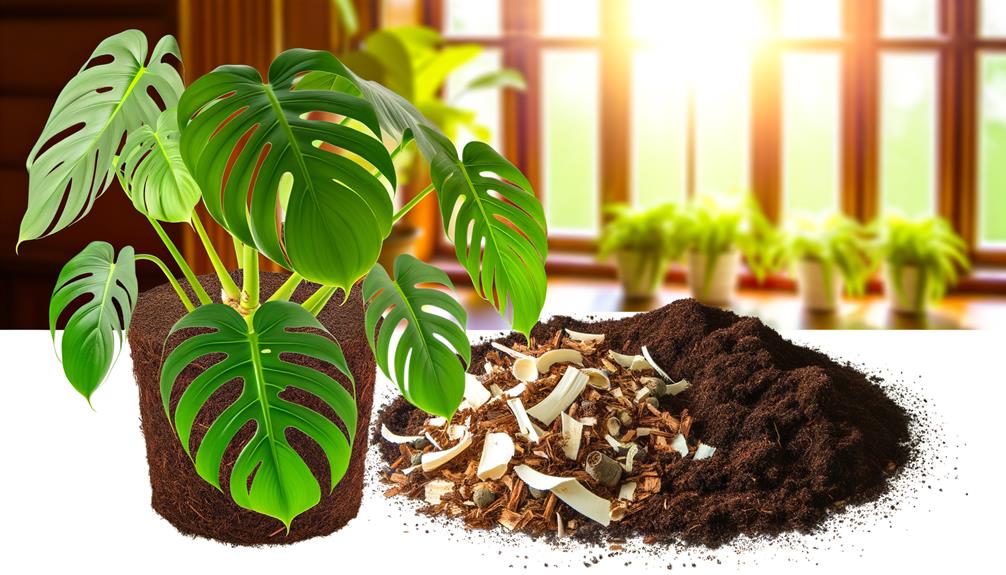
To cultivate a healthy Monstera Adansonii, you must first understand its specific requirements for light, humidity, and soil composition.
This tropical plant thrives in bright, indirect light, mimicking the dappled sunlight of its native rainforest habitat. Direct sunlight can scorch its leaves, so place it near a north or east-facing window.
Maintaining a high humidity level, around 60-80%, is essential. You can achieve this by using a humidifier or placing the plant on a pebble tray with water.
For soil, Monstera Adansonii prefers a well-aerated mix that retains moisture but allows excess water to drain. Incorporating organic matter like peat moss enhances nutrient availability, and perlite or orchid bark improves aeration, promoting robust root health.
Importance of Well-Draining Soil
Promoting well-draining soil is crucial for Monstera Adansonii because it prevents root rot and other water-related issues. When soil retains excess moisture, it creates an anaerobic environment, fostering pathogens like Pythium and Phytophthora, which attack the roots.
Well-draining soil mitigates this risk by allowing excess water to escape, maintaining an ideal balance of aeration and moisture levels.
You should aim for a soil mix that includes components like perlite or pumice to improve drainage. Research indicates that soil structure impacts root health and overall plant vigor. Inadequate drainage can lead to hypoxia, stunting growth, and increasing susceptibility to diseases.
Hence, selecting a well-draining substrate ensures your Monstera Adansonii thrives in a balanced, healthy environment.
Organic Matter and Nutrients
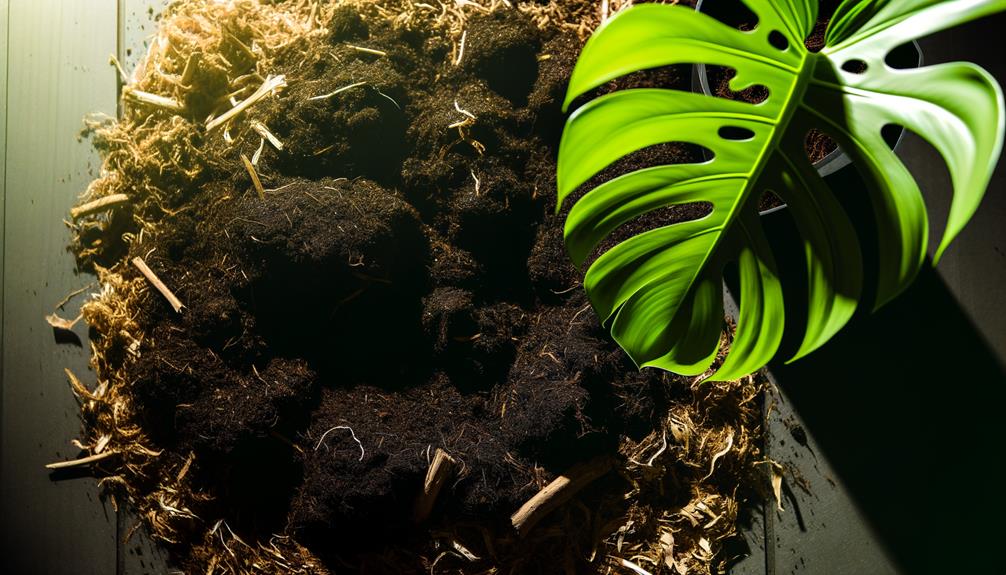
Incorporating organic matter into the soil mix enriches it with essential nutrients that support the robust growth of Monstera Adansonii. Organic matter, such as compost or well-ripened manure, enhances soil structure, moisture retention, and microbial activity. These elements improve nutrient availability and root health.
For an ideal soil mix, consider including:
- Compost: Provides a balanced nutrient profile and improves soil texture.
- Worm castings: Rich in beneficial microorganisms and essential nutrients.
- Coco coir: Enhances water retention while maintaining aeration.
- Perlite: Guarantees proper drainage and prevents soil compaction.
Ideal Soil Ph Levels
For best growth, you should maintain the soil pH for Monstera Adansonii within the range of 5.5 to 7.0, as this range maximizes nutrient availability.
Regularly test the soil pH using a dependable pH meter or test kit to uphold these levels.
Adjust the pH by adding garden lime to raise it or sulfur to lower it, based on test results.
Optimal Ph Range
Maintaining an ideal pH range of 5.5 to 7.0 is crucial for Monstera adansonii, as it directly impacts nutrient availability and overall plant health. When the soil pH falls within this range, your plant can effectively absorb critical nutrients like nitrogen, phosphorus, and potassium.
Deviations can lead to nutrient lockout, causing deficiencies and stunted growth.
Key factors influenced by best pH levels include:
- Nutrient Uptake: Proper pH ensures essential minerals are accessible.
- Microbial Activity: Beneficial soil organisms thrive in this pH range.
- Root Health: Balanced pH supports strong root development.
- Disease Resistance: Best pH strengthens the plant’s natural defenses.
Testing Soil Ph
To ensure your Monstera adansonii thrives, you should regularly check the soil acidity level using reliable methods like pH meters or soil test kits. A pH meter, which provides digital readings, is highly precise. For accuracy, insert the probe into moist soil, avoiding dry patches.
Alternatively, soil test kits offer colorimetric results; mix soil with a provided solution and compare the color change to a pH chart. Monstera adansonii prefers a slightly acidic to neutral pH range, ideally between 5.5 and 7.0. Regular monitoring helps you maintain ideal conditions, ensuring nutrient availability and preventing deficiencies.
Correct any deviations using amendments like sulfur to lower pH or lime to raise it, thereby promoting robust plant health.
Components of the Perfect Soil Mix
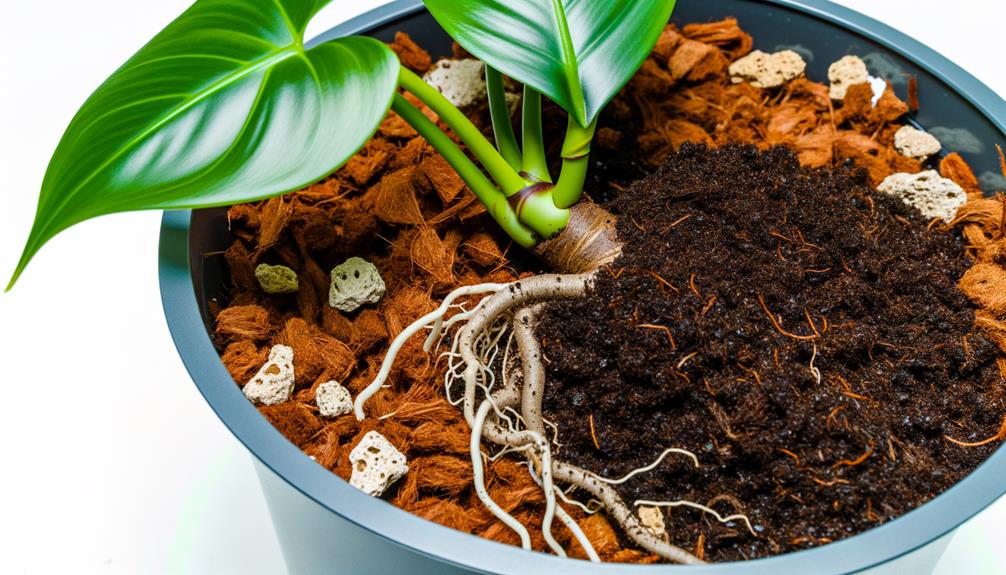
To cultivate a thriving Monstera Adansonii, you need to prioritize soil mix components that enhance drainage and aeration, preventing root rot.
Incorporate perlite or orchid bark to guarantee sufficient air flow, and blend in organic matter like compost to provide essential nutrients.
This combination creates an ideal environment for root health and sustained growth.
Drainage and Aeration Importance
Establishing proper drainage and aeration in your soil mix is fundamental for the health and growth of Monstera Adansonii. It prevents root rot and allows for optimal nutrient uptake. Without sufficient drainage, water can accumulate around the roots, causing anaerobic conditions that lead to fungal infections. Similarly, aeration ensures that oxygen reaches the root system, facilitating cellular respiration and efficient nutrient absorption.
To optimize drainage and aeration, consider the following components:
- Perlite: Enhances soil structure and increases aeration.
- Pumice: Provides excellent drainage and retains minimal moisture.
- Bark chips: Improve soil aeration and create air pockets.
- Coarse sand: Aids in preventing soil compaction and enhances drainage.
Selecting these components will create a well-draining and aerated environment essential for your plant’s well-being.
Nutrient-Rich Additives
A well-mixed soil blend for Monstera Adansonii benefits greatly from nutrient-rich additions like worm castings, compost, and slow-releasing fertilizers, which provide essential macro and micronutrients for robust growth.
Worm castings are rich in nitrogen, phosphorus, and potassium, enhancing soil structure and microbial activity. Compost introduces organic materials, improving soil fertility and moisture retention. Slow-releasing fertilizers ensure a steady supply of nutrients over time, preventing deficiencies.
Incorporate these additions in measured amounts to avoid nutrient imbalances. Aim for a balanced N-P-K ratio tailored to Monstera’s needs, typically a 20-20-20 formulation. Regularly monitor soil pH and nutrient levels using soil test kits to maintain ideal conditions.
These practices promote healthy foliage and vigorous root development.
DIY Soil Mix Recipe
Crafting a DIY soil mix for your Monstera Adansonii guarantees peak root health and vigorous growth. Start with a balanced blend that guarantees proper aeration, moisture retention, and nutrient availability.
Combine these components for an ideal mix:
- Coco coir: Promotes moisture retention and root aeration due to its fibrous structure.
- Perlite: Enhances drainage and prevents soil compaction, essential for root breathability.
- Pine bark fines: Adds organic matter, improves soil structure, and supports microbial activity.
- Worm castings: Provides a slow-release nutrient source, rich in essential minerals and beneficial microorganisms.
This combination ensures a well-draining, nutrient-rich medium that closely mimics the Monstera’s natural habitat.
Regularly monitor the soil’s moisture levels and adjust the mix as needed to maintain optimal growing conditions.
Store-Bought Soil Options
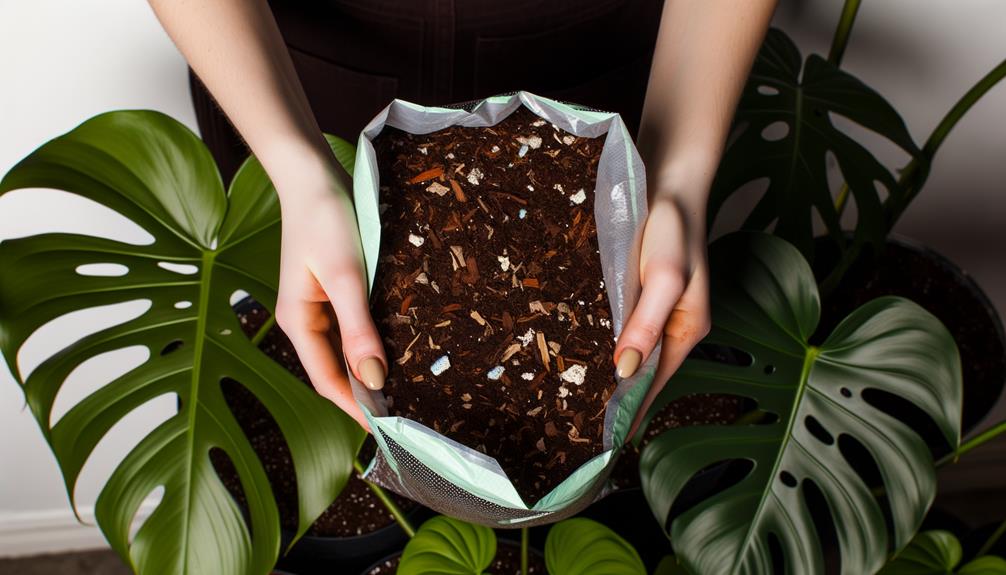
For those who prefer convenience over DIY, several store-bought soil options are specifically formulated to meet the unique needs of Monstera Adansonii, ensuring best drainage, aeration, and nutrient availability.
These mixes often include components like perlite, orchid bark, and peat moss to optimize plant health. Choosing a soil that balances water retention with air pockets is crucial to prevent root rot and promote robust growth.
| Brand | Features |
|---|---|
| Miracle-Gro | Contains perlite for aeration |
| FoxFarm | Rich in organic matter |
| Black Gold | Enhanced with mycorrhizae for root health |
| Espoma | Peat-free, includes perlite and sand |
| Hoffman | Specially formulated for tropical plants |
Each brand offers a distinctive blend, so assess your plant’s specific requirements before making a choice.
Best Pot For Monstera Adansonii
The best pot for Monstera adansonii should have the following features:
- Drainage: Ensure the pot has drainage holes to prevent waterlogging, which can lead to root rot.
- Size: Choose a pot that is slightly larger than the plant’s current root ball, allowing room for growth but not too large to avoid excessive soil that retains moisture.
- Material: Terracotta pots are ideal as they are porous and help with moisture control. Plastic pots are also acceptable but monitor watering carefully.
- Shape: A pot with a wide base can provide stability for the trailing growth habit of Monstera adansonii.
These features will help maintain healthy roots and overall plant health.
Tips for Repotting
When repotting your Monstera Adansonii, make sure you choose a pot that’s 1-2 inches larger in diameter than the current one to allow room for growth and proper root development. Carefully remove the plant from its old pot to avoid damaging the roots. Inspect the root ball for signs of rot or disease, trimming any unhealthy sections with sterilized scissors.
Position the plant in the new pot and fill it with well-draining soil, ensuring the root crown is level with the soil surface. Water thoroughly to help settle the soil.
- Select a pot with drainage holes for ideal water management.
- Use a soil mix specifically designed for aroids.
- Water moderately after repotting to avoid waterlogging.
- Place in indirect light to reduce transplant shock.
Conclusion
By now, you know that the secret to a thriving Monstera adansonii lies beneath the surface. Imagine roots dancing through a well-draining, nutrient-rich soil mix, balanced in pH.
Whether you opt for a DIY recipe or a store-bought option, verify it meets the plant’s specific needs. Repotting with care will set the stage for lush growth.
Remember, the right soil is the foundation for your Monstera’s verdant performance.

